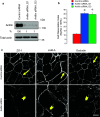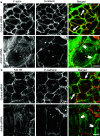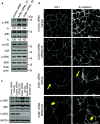F-actin binding protein, anillin, regulates integrity of intercellular junctions in human epithelial cells
- PMID: 25809162
- PMCID: PMC4506886
- DOI: 10.1007/s00018-015-1890-6
F-actin binding protein, anillin, regulates integrity of intercellular junctions in human epithelial cells
Abstract
Tight junctions (TJ) and adherens junctions (AJ) are key morphological features of differentiated epithelial cells that regulate the integrity and permeability of tissue barriers. Structure and remodeling of epithelial junctions depends on their association with the underlying actomyosin cytoskeleton. Anillin is a unique scaffolding protein interacting with different cytoskeletal components, including actin filaments and myosin motors. Its role in the regulation of mammalian epithelial junctions remains unexplored. Downregulation of anillin expression in human prostate, colonic, and lung epithelial cells triggered AJ and TJ disassembly without altering the expression of junctional proteins. This junctional disassembly was accompanied by dramatic disorganization of the perijunctional actomyosin belt; while the general architecture of the actin cytoskeleton, and activation status of non-muscle myosin II, remained unchanged. Furthermore, loss of anillin disrupted the adducin-spectrin membrane skeleton at the areas of cell-cell contact, selectively decreased γ-adducin expression, and induced cytoplasmic aggregation of αII-spectrin. Anillin knockdown activated c-Jun N-terminal kinase (JNK), and JNK inhibition restored AJ and TJ integrity and cytoskeletal organization in anillin-depleted cells. These findings suggest a novel role for anillin in regulating intercellular adhesion in model human epithelia by mechanisms involving the suppression of JNK activity and controlling the assembly of the perijunctional cytoskeleton.
Figures









Similar articles
-
Adducins regulate remodeling of apical junctions in human epithelial cells.Mol Biol Cell. 2010 Oct 15;21(20):3506-17. doi: 10.1091/mbc.E10-03-0259. Epub 2010 Sep 1. Mol Biol Cell. 2010. PMID: 20810786 Free PMC article.
-
Actin-interacting protein 1 controls assembly and permeability of intestinal epithelial apical junctions.Am J Physiol Gastrointest Liver Physiol. 2015 May 1;308(9):G745-56. doi: 10.1152/ajpgi.00446.2014. Epub 2015 Mar 19. Am J Physiol Gastrointest Liver Physiol. 2015. PMID: 25792565 Free PMC article.
-
Anillin regulates cell-cell junction integrity by organizing junctional accumulation of Rho-GTP and actomyosin.Curr Biol. 2014 Jun 2;24(11):1263-70. doi: 10.1016/j.cub.2014.04.021. Epub 2014 May 15. Curr Biol. 2014. PMID: 24835458 Free PMC article.
-
RhoGTPases, actomyosin signaling and regulation of the epithelial Apical Junctional Complex.Semin Cell Dev Biol. 2014 Dec;36:194-203. doi: 10.1016/j.semcdb.2014.09.003. Epub 2014 Sep 16. Semin Cell Dev Biol. 2014. PMID: 25223584 Free PMC article. Review.
-
Unique and redundant functions of cytoplasmic actins and nonmuscle myosin II isoforms at epithelial junctions.Ann N Y Acad Sci. 2022 Sep;1515(1):61-74. doi: 10.1111/nyas.14808. Epub 2022 Jun 7. Ann N Y Acad Sci. 2022. PMID: 35673768 Free PMC article. Review.
Cited by
-
Anillin tunes contractility and regulates barrier function during Rho flare-mediated tight junction remodeling.Mol Biol Cell. 2025 Mar 1;36(3):ar31. doi: 10.1091/mbc.E24-11-0513. Epub 2025 Jan 22. Mol Biol Cell. 2025. PMID: 39841565 Free PMC article.
-
Pancreatic Ductal Adenocarcinoma Cortical Mechanics and Clinical Implications.Front Oncol. 2022 Jan 31;12:809179. doi: 10.3389/fonc.2022.809179. eCollection 2022. Front Oncol. 2022. PMID: 35174086 Free PMC article. Review.
-
Porcine circovirus type 2 exploits JNK-mediated disruption of tight junctions to facilitate Streptococcus suis translocation across the tracheal epithelium.Vet Res. 2020 Feb 27;51(1):31. doi: 10.1186/s13567-020-00756-2. Vet Res. 2020. PMID: 32106883 Free PMC article.
-
The Blood-prostate Barrier: An Obstacle to Drug Delivery into the Prostate.Curr Drug Deliv. 2025;22(4):401-412. doi: 10.2174/1567201821666230807152520. Curr Drug Deliv. 2025. PMID: 37550915 Review.
-
Anillin is an emerging regulator of tumorigenesis, acting as a cortical cytoskeletal scaffold and a nuclear modulator of cancer cell differentiation.Cell Mol Life Sci. 2021 Jan;78(2):621-633. doi: 10.1007/s00018-020-03605-9. Epub 2020 Sep 3. Cell Mol Life Sci. 2021. PMID: 32880660 Free PMC article. Review.
References
Publication types
MeSH terms
Substances
Grants and funding
LinkOut - more resources
Full Text Sources
Other Literature Sources
Research Materials
Miscellaneous

